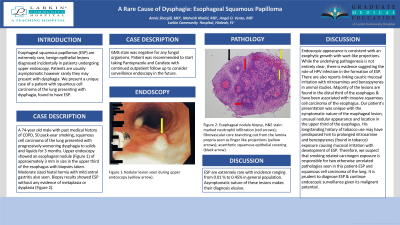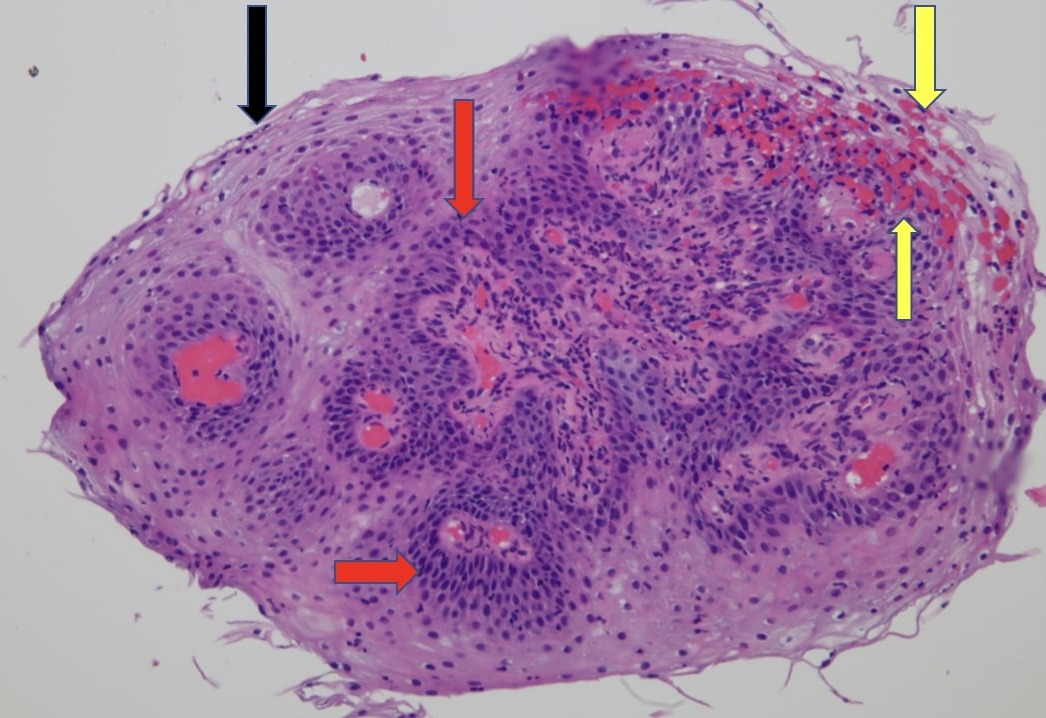Sunday Poster Session
Category: Esophagus
P0490 - A Rare Cause of Dysphagia: Esophageal Squamous Papilloma
Sunday, October 22, 2023
3:30 PM - 7:00 PM PT
Location: Exhibit Hall

Has Audio

Annie Shergill, MD
Larkin Community Hospital
Miami, FL
Presenting Author(s)
Annie Shergill, MD1, Angel O. Vento, MD1, Mahvish Khalid, MD2
1Larkin Community Hospital, Miami, FL; 2Larkin Community Hospital, Plam Springs Campus, Miami, FL
Introduction: Esophageal squamous papillomas (ESP) are extremely rare, benign epithelial lesions diagnosed incidentally in patients undergoing upper endoscopy. Patients are usually asymptomatic however rarely they may present with dysphagia. We present a unique case of a patient with squamous cell carcinoma of the lung presenting with dysphagia, found to have ESP.
Case Description/Methods: A 74-year old male with past medical history of COPD, 50 pack-year smoking, squamous cell carcinoma of the lung presented with progressively worsening dysphagia to solids and liquids for 3 months. Upper endoscopy showed an esophageal nodule of approximately 3 mm in size in the upper third of the esophagus with biopsies taken. Moderate sized hiatal hernia with mild antral gastritis also seen. Biopsy results showed ESP without any evidence of metaplasia or dysplasia (Figure 1). GMS stain negative for any fungal organisms. Patient was recommended to start taking Pantoprazole and Carafate with continued outpatient follow up to consider surveillance endoscopy in the future.
Discussion: ESP are extremely rare with incidence ranging from 0.01 % to 0.45% in general population. Asymptomatic nature of these lesions makes their diagnosis elusive. Endoscopic appearance is consistent with an exophytic growth with wart-like projections. While the underlying pathogenesis is not entirely clear, there is evidence suggesting the role of HPV infection in the formation of ESP. There are also reports linking caustic mucosal irritation with nitrosamines and benzopyrenes in animal studies. Majority of the lesions are found in the distal third of the esophagus & have been associated with invasive squamous cell carcinoma of the esophagus. Our patient’s presentation was unique with the symptomatic nature of the esophageal lesion, unusual nodular appearance and location in the upper third of the esophagus. His longstanding history of tobacco use may have predisposed him to prolonged nitrosamine and benzopyrenes (found in tobacco) exposure causing mucosal irritation with development of ESP. Therefore, we suspect that smoking related carcinogen exposure is responsible for two otherwise unrelated pathologies seen in this patient-ESP and squamous cell carcinoma of the lung. It is prudent to diagnose ESP & continue endoscopic surveillance given its malignant potential.

Disclosures:
Annie Shergill, MD1, Angel O. Vento, MD1, Mahvish Khalid, MD2. P0490 - A Rare Cause of Dysphagia: Esophageal Squamous Papilloma, ACG 2023 Annual Scientific Meeting Abstracts. Vancouver, BC, Canada: American College of Gastroenterology.
1Larkin Community Hospital, Miami, FL; 2Larkin Community Hospital, Plam Springs Campus, Miami, FL
Introduction: Esophageal squamous papillomas (ESP) are extremely rare, benign epithelial lesions diagnosed incidentally in patients undergoing upper endoscopy. Patients are usually asymptomatic however rarely they may present with dysphagia. We present a unique case of a patient with squamous cell carcinoma of the lung presenting with dysphagia, found to have ESP.
Case Description/Methods: A 74-year old male with past medical history of COPD, 50 pack-year smoking, squamous cell carcinoma of the lung presented with progressively worsening dysphagia to solids and liquids for 3 months. Upper endoscopy showed an esophageal nodule of approximately 3 mm in size in the upper third of the esophagus with biopsies taken. Moderate sized hiatal hernia with mild antral gastritis also seen. Biopsy results showed ESP without any evidence of metaplasia or dysplasia (Figure 1). GMS stain negative for any fungal organisms. Patient was recommended to start taking Pantoprazole and Carafate with continued outpatient follow up to consider surveillance endoscopy in the future.
Discussion: ESP are extremely rare with incidence ranging from 0.01 % to 0.45% in general population. Asymptomatic nature of these lesions makes their diagnosis elusive. Endoscopic appearance is consistent with an exophytic growth with wart-like projections. While the underlying pathogenesis is not entirely clear, there is evidence suggesting the role of HPV infection in the formation of ESP. There are also reports linking caustic mucosal irritation with nitrosamines and benzopyrenes in animal studies. Majority of the lesions are found in the distal third of the esophagus & have been associated with invasive squamous cell carcinoma of the esophagus. Our patient’s presentation was unique with the symptomatic nature of the esophageal lesion, unusual nodular appearance and location in the upper third of the esophagus. His longstanding history of tobacco use may have predisposed him to prolonged nitrosamine and benzopyrenes (found in tobacco) exposure causing mucosal irritation with development of ESP. Therefore, we suspect that smoking related carcinogen exposure is responsible for two otherwise unrelated pathologies seen in this patient-ESP and squamous cell carcinoma of the lung. It is prudent to diagnose ESP & continue endoscopic surveillance given its malignant potential.

Figure: Figure 1: Esophageal nodule biopsy, H&E stain: marked neutrophil infiltration (red arrows); fibrovascular core branching out from the lamina propria seen as finger like projections (yellow arrows); acanthotic squamous epithelial covering (black arrow).
Disclosures:
Annie Shergill indicated no relevant financial relationships.
Angel Vento indicated no relevant financial relationships.
Mahvish Khalid indicated no relevant financial relationships.
Annie Shergill, MD1, Angel O. Vento, MD1, Mahvish Khalid, MD2. P0490 - A Rare Cause of Dysphagia: Esophageal Squamous Papilloma, ACG 2023 Annual Scientific Meeting Abstracts. Vancouver, BC, Canada: American College of Gastroenterology.
